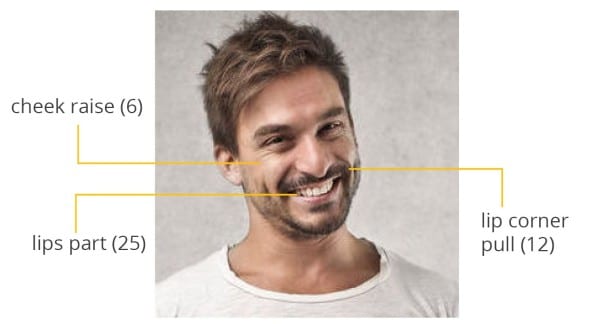Explore the Duchenne Smile and 18 other facial expressions, their emotional meanings, and the FACS Action Units that define human emotion.
Table of Contents
- Introduction
- Understanding FACS: The Science Behind Facial Expression Analysis
- What Is the Duchenne Smile?
- Positive and Social Smiles
- Mixed and Complex Smiles
- Negative Emotion Expressions
- Why Facial Expressions Matter in Emotion Research
- Quick Reference Table of Facial Expressions
- Final Thoughts
- Free 42-page Facial Expression Analysis Guide
Introduction
Facial expressions are the most universal form of nonverbal communication. Before we speak, our faces convey what we feel – joy, embarrassment, disgust, or fear. Among them, the Duchenne Smile stands out as the hallmark of genuine happiness.
But there’s much more to our emotional display repertoire. Using the Facial Action Coding System (FACS), researchers have identified dozens of expressions that reveal the emotional meaning of human expressions. Below, we explore the most studied expressions – from authentic smiles to the grimaces of fear – and list the Action Units (AUs) that shape each one.
Understanding FACS: The Science Behind Facial Expression Analysis
Developed by Paul Ekman and Wallace Friesen, the Facial Action Coding System (FACS) is a comprehensive framework that maps facial muscle movements into distinct Action Units (AUs). Each AU corresponds to a specific muscle or group of muscles, allowing scientists to objectively decode emotional states.
Modern tools like automated facial expression analysis in iMotions leverage FACS to identify, quantify, and synchronize emotional signals in real time, from joy to contempt, attention to stress.

What Is the Duchenne Smile?
The Duchenne Smile is the classic genuine smile, named after neurologist Guillaume Duchenne, who identified that true happiness activates both the zygomatic major (lifting the mouth corners – AU12) and the orbicularis oculi (crinkling the eyes – AU6).
Unlike polite or “Pan-Am” smiles that engage only the mouth, a Duchenne Smile radiates authentic joy. Yet it’s only one of many distinct expressions humans use. From Affiliative, Coy, and Embarrassment Smiles to Dominance Smirks and Fear Grimaces, each configuration of facial muscles tells a different emotional story.
The Duchenne Smile may be the best-known, but it’s part of a far broader emotional vocabulary, that is a clear reminder that the human face speaks many dialects when communicating feelings and emotions.
Positive and Social Smiles
1. Duchenne Smile (Genuine Enjoyment Smile)
Emotion: Authentic joy, amusement, contentment
- FACS AUs: AU6 (cheek raiser), AU12 (lip corner puller)
- A spontaneous, genuine smile involving both the eyes and mouth. Considered the true marker of happiness.
2. Pan-Am Smile (Social or Non-Duchenne Smile)
Emotion: Politeness, social courtesy
- FACS AUs: AU12 (lip corner puller)
- A mouth-only smile used in social contexts, lacking the eye involvement that signals authentic pleasure.
3. Reward Smile
Emotion: Pleasure, reinforcement, approval
- FACS AUs: AU6 + AU12 + AU25 (lips part)
- Expresses satisfaction or reward; often occurs with positive feedback or laughter.
4. Affiliative Smile
Emotion: Warmth, friendliness, bonding
- FACS AUs: AU12 (+ optional AU1/AU2 brow raise)
- Used to foster social connection and trust; often seen in cooperative or supportive interactions.
5. Dominance Smile
Emotion: Pride, confidence, superiority
- FACS AUs: AU12 + AU14 (dimpler, often asymmetrical)
- A smirk signaling control or authority — common in hierarchical social dynamics.
6. Coy Smile
Emotion: Flirtation, shyness, modesty
- FACS AUs: AU6 + AU12, with head tilt or gaze aversion
- Combines warmth with self-consciousness, signaling playful submission or attraction.
7. Embarrassment Smile
Emotion: Social awkwardness, self-consciousness
- FACS AUs: AU12 + AU6 + AU1 + AU4, often with downward gaze
- Appears after a social misstep; conveys appeasement and humility.
8. Amusement Smile / Laughter Face
Emotion: Mirth, humor, joy
- FACS AUs: AU6 + AU12 + AU25 (lips part) + AU26 (jaw drop)
- The open-mouthed Duchenne variant that accompanies laughter and genuine fun.

9. Pride Expression
Emotion: Accomplishment, confidence
- FACS AUs: AU12 + AU53 (head back) + AU57 (head up)
- Usually paired with an expanded chest posture, signaling success or authority.
Mixed and Complex Smiles
10. Sad Smile
Emotion: Bittersweetness, nostalgia, empathy
- FACS AUs: AU12 + AU1 (inner brow raise) + AU4 (brow lower)
- Combines a small smile with sorrowful eyes, often seen in compassionate moments.
11. Fear Grimace / Submissive Smile
Emotion: Nervousness, anxiety, appeasement
- FACS AUs: AU12 + AU25 (lips part) + AU26 (jaw drop) + AU1
- Looks like a smile but reflects fear or discomfort; common in hierarchical animal and human behavior.
12. Contempt Expression
Emotion: Disdain, moral superiority
- FACS AUs: AU14 (dimpler) or unilateral AU12
- A one-sided smirk or tightening of one lip corner expressing scorn.
Negative Emotion Expressions
13. Anger Expression
Emotion: Hostility, frustration, determination
- FACS AUs: AU4 (brow lower) + AU5 (upper lid raise) + AU7 (lid tighten) + AU23 (lip tighten)
- Brows knit together, eyes glare — the face of confrontation and control.
14. Disgust Expression
Emotion: Sensory or moral aversion
- FACS AUs: AU9 (nose wrinkle) + AU10 (upper lip raise)
- A reflexive reaction to unpleasant stimuli, often accompanied by head retraction.
15. Fear Expression
Emotion: Alarm, threat detection
- FACS AUs: AU1 + AU2 + AU4 + AU5 + AU20 + AU25/26
- Wide-eyed and open-mouthed, designed to maximize sensory awareness.
16. Surprise Expression
Emotion: Startle, novelty
- FACS AUs: AU1 + AU2 + AU5 + AU26
- Similar to fear but neutral in valence; reflects cognitive appraisal of the unexpected.
17. Sadness Expression
Emotion: Sorrow, loss, empathy
- FACS AUs: AU1 + AU4 + AU15 (lip corner depressor) + AU17 (chin raise)
- The drooping mouth and raised inner brows universally signal sadness.
18. Embarrassment / Shame Blend
Emotion: Guilt, humility, self-awareness
- FACS AUs: AU12 + AU1 + AU4, often with gaze down or face touch
- Shows self-conscious emotion and a desire for social repair.
19. Neutral or Suppressed Expression
Emotion: Control, masking
- FACS AUs: None dominant; micro-AUs may appear transiently
- Absence of expression can signal professionalism, suppression, or neutrality.
Why Facial Expressions Matter in Emotion Research
Facial expressions are biological communication systems — they evolved to help humans and animals signal internal states, intentions, and social boundaries.
Understanding these expressions through FACS allows behavioral scientists to decode emotional authenticity, study emotional contagion, and analyze audience or consumer reactions in controlled and natural environments.
Using automated FACS-based tools in iMotions, researchers can:
- Detect spontaneous vs posed emotion (Duchenne vs Pan-Am)
- Track emotional valence and intensity frame-by-frame
- Synchronize facial data with EEG, GSR, or voice analysis for multimodal insights
These integrations open new frontiers in emotion AI, UX testing, psychology, marketing, and human factors research.
Quick Reference Table of Facial Expressions
| Expression | Emotion | Common AUs | Meaning |
| Duchenne Smile | Genuine Joy | AU6 + AU12 | Authentic happiness |
| Pan-Am Smile | Politeness | AU12 | Social courtesy |
| Reward Smile | Pleasure | AU6 + AU12 + AU25 | Positive reinforcement |
| Affiliative Smile | Warmth | AU12 (+ AU1/2) | Connection |
| Dominance Smile | Pride | AU12 + AU14 | Superiority |
| Coy Smile | Shyness | AU6 + AU12 | Flirtation |
| Embarrassment Smile | Self-consciousness | AU6 + AU12 + AU1/4 | Appeasement |
| Amusement Smile | Mirth | AU6 + AU12 + AU25/26 | Laughter |
| Sad Smile | Nostalgia | AU12 + AU1 + AU4 | Mixed affect |
| Fear Grimace | Anxiety | AU12 + AU25/26 + AU1 | Nervousness |
| Contempt | Disdain | AU14 or AU12 unilateral | Scorn |
| Anger | Hostility | AU4 + AU5 + AU7 + AU23 | Confrontation |
| Disgust | Aversion | AU9 + AU10 | Revulsion |
| Fear | Alarm | AU1+2+4+5+20+25/26 | Threat detection |
| Surprise | Startle | AU1+2+5+26 | Unexpectedness |
| Sadness | Sorrow | AU1+4+15+17 | Loss |
| Embarrassment/Shame | Guilt | AU12 + AU1 + AU4 | Self-awareness |
| Neutral | Control | None dominant | Suppression |
Final Thoughts
Facial expressions are the windows to human emotion – rich, nuanced, and deeply revealing. The Duchenne Smile may be the most famous, but understanding the full taxonomy of facial expressions enables deeper insight into how humans feel, think, and connect.
With automated FACS analysis and multimodal integration in platforms like iMotions, researchers can now quantify emotion with unprecedented accuracy – bridging physiology, cognition, and affect to truly understand what it means to be human.
Free 42-page Facial Expression Analysis Guide
For Beginners and Intermediates
- Get a thorough understanding of all aspects
- Valuable facial expression analysis insights
- Learn how to take your research to the next level












